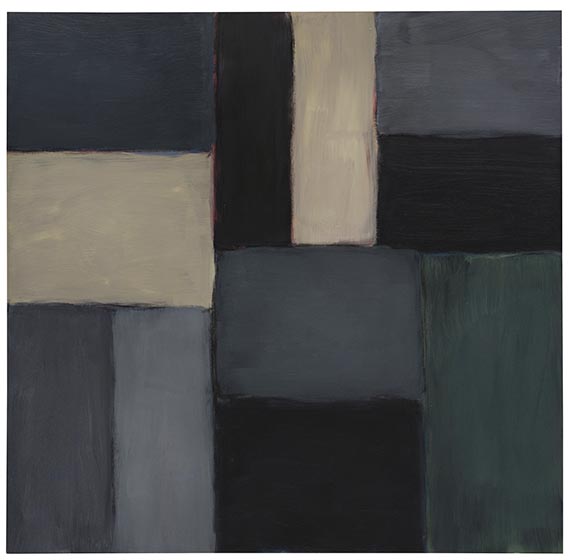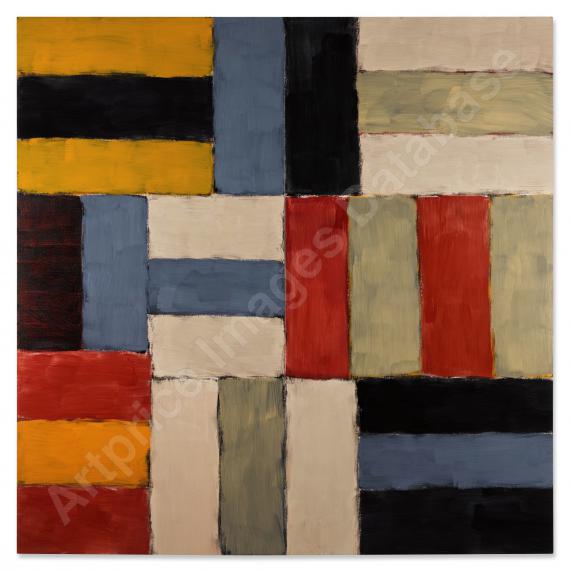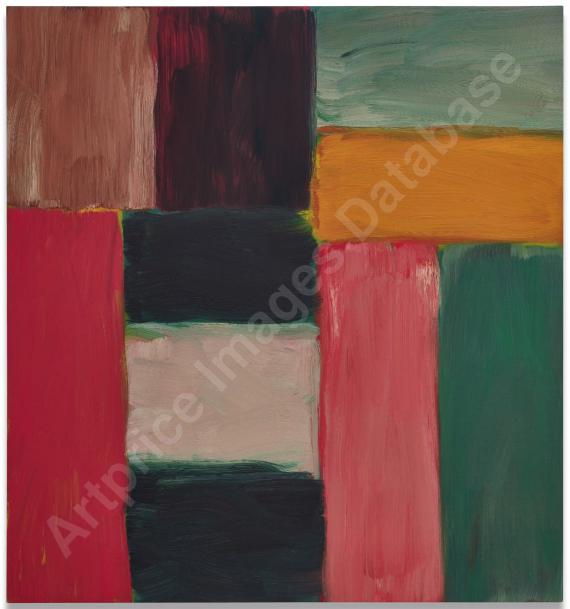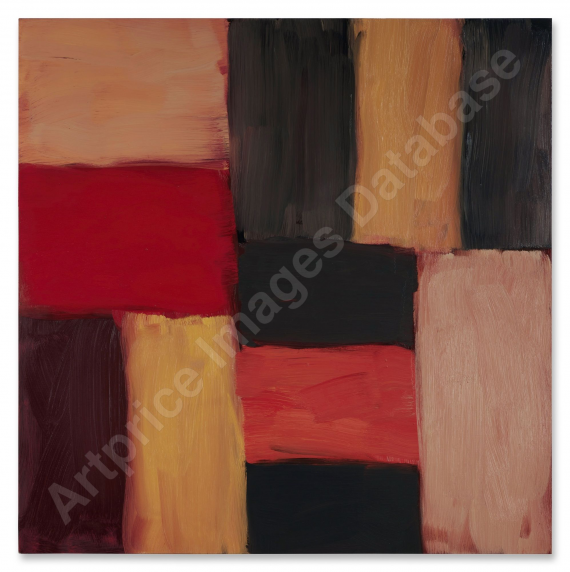Sale: 550 / Evening Sale, June 07. 2024 in Munich  Lot 124000335
Lot 124000335
 Lot 124000335
Lot 124000335
124000335
Sean Scully
Wall of Light Green Grey, 2008.
Oil on aluminum
Estimate:
€ 400,000 - 600,000
$ 428,000 - 642,000
Information on buyer's premium, taxation and resale right compensation will be available four weeks before the auction.
Wall of Light Green Grey. 2008.
Oil on aluminum.
Signed, dated “10.08” and titled, as well as with a typographically inscribed artist's label on the reverse. 152.5 x 152.5 x 5.5 cm (60 x 60 x 2.1 in).
• “Wall of Light” is among the most important and most critically acclaimed series in Scully's oeuvre.
• Chromatic mysteries: Hidden layers of color shimmer between the color fields, revealing a much brighter palette than the restrained monochrome suggests upon first impression.
• Other works from this series are at the Metropolitan Museum of Art and the Solomon R. Guggenheim Museum in New York, as well as at the National Gallery of Art in Washington and the Museum of Fine Arts in Boston.
• In 2005, this series was the subject of Scully's first comprehensive solo show at the Metropolitan Museum of Art in New York, also mounted at the Phillips Collection in Washington, the Modern Art Museum of Fort Worth, and the Cincinnati Art Museum.
PROVENANCE: Walter Storms Galerie, Munich.
Private collection Southern Germany (acqquired from the above in 2009).
Oil on aluminum.
Signed, dated “10.08” and titled, as well as with a typographically inscribed artist's label on the reverse. 152.5 x 152.5 x 5.5 cm (60 x 60 x 2.1 in).
• “Wall of Light” is among the most important and most critically acclaimed series in Scully's oeuvre.
• Chromatic mysteries: Hidden layers of color shimmer between the color fields, revealing a much brighter palette than the restrained monochrome suggests upon first impression.
• Other works from this series are at the Metropolitan Museum of Art and the Solomon R. Guggenheim Museum in New York, as well as at the National Gallery of Art in Washington and the Museum of Fine Arts in Boston.
• In 2005, this series was the subject of Scully's first comprehensive solo show at the Metropolitan Museum of Art in New York, also mounted at the Phillips Collection in Washington, the Modern Art Museum of Fort Worth, and the Cincinnati Art Museum.
PROVENANCE: Walter Storms Galerie, Munich.
Private collection Southern Germany (acqquired from the above in 2009).
Walls of Light
“Wall of Light Green Grey” visualizes the relationship between light and shadow, color and form, hence embodying the essence of the “Wall of Light” series, a body of works formative for Sean Scully's work and career over the past 25 years.
Scully described several trips to Mexico in the 1980s as a key moment for the creation of these works, as he was particularly fascinated by the play of light and shadow on the floors of the Mayan pyramids made of innumerable stone blocks in Chichén Itzá on the Yucatán Peninsula. Illuminated by the sun, they inspired him to create a series of watercolors. “Seeing the Mexican ruins, the stacking of the stones, and the way the light hit those façades, had something to do with it, maybe everything to do with it”, explains the artist (quoted from: ex. cat. Sean Scully. Wall of Light, Phillips Collection, Washington D. C., 2005, p. 24). Henceforth, Scully turned to a much less strictly geometric structure than in his earlier works.
Years later, in retrospect of the profound impressions gained in Mexico, he created the first "Wall of Light" works in 1998, which include paintings, watercolors, pastels, and prints. In contrast to his earlier paintings, in which Scully often still traversed the canvas with long strips of color, the “Wall of Light” paintings exclusively come in vertical and horizontal blocks of color of varying widths and lengths, which Scully assembles like a brick wall.
The glossy materiality and the radiance of the oil paints, the special surface texture resulting from the visible brushwork, and, above all, the spaces between the individual blocks of paint, the soft, deliberately imprecise transitions become even more prominent in these works. “If the basic concern of his 1980s panels was the aesthetics of conflict - what happens with what, when you crash panels with stripes of varied colors, orientations, and widths into one another -, the concern of these more recent pictures is ideal harmony. Scully's Walls of Light are Arcadian paintings", explains the American art philosopher and cultural critic David Carrier (quoted from: Putting Abstraction in Touch with Reality. The Achievement of Sean Scully, in: ex. cat. Passenger. A Retrospective, Budapest 2020/21, p. 217).
Reading between the lines
These narrow gaps at the transitions between the individual color fields are the result of a supposed 'imperfection' of the painting process, but it is only here that the secret of the pictures and Scully's painting can be revealed: beneath the subtle shiny black, sandy beige and stone grey, hidden layers of color shine through, exposing a completely different palette than the restrained monochrome of our painting initially suggests. The reduced use of color allows us to focus on what lies underneath: we see a radiant blue, fresh, cool green, almost turquoise, and delicate pink changing to various shades of red can be seen there and suddenly change the entire effect of the painting. “There are no simple colors in my work.. there are no whites, no reds. Colors are always subverted by the colors underneath, so when you're looking at something you're never quite sure what you're looking at” (S. Scully, quoted from: Hossein Amirsadeghi/Maryam Homayoun Eisler (eds.), Sanctuary: Britain's Artists and their Studios, London, 2011, p. 112).
Scully achieves this effect through the time-consuming layering of the paint. A technique that testifies to the strong influence of American Abstract Expressionism, especially the vibrant color fields of Mark Rothko, had on his work. As with Rothko, the supposedly concealed, deeper colors are not completely hidden due to the manual application of the paint. Instead, the color enters the stage at the soft borders and transitions of the individual fields and fills the entire pictorial surface with sensual vitality. In combination with the painterly brushstroke, the work makes the intensive painting process tangible, the creative energy invested in it. What has already been painted over, the past, becomes visible and a long-gone state reappears. “I think there is a lot of melancholia in my paintings. There is a sense of loss. [..] It seems that one of the worst things about the human condition is that it is not possible to go back in your life. [..] You never get a second chance to do anything, to even breathe the same breath again. It's gone as soon as you've done it, and somehow this is reflected in my work. The paintings are an attempt to stop that process. They have a lot of processes in them, but it's all frozen in time.” (Sean Scully in a conversation with Hans-Michael Herzog, New York, December 13, 1998)
A strong commitment to abstraction
The title of our work, as well as the series “Wall of Light” evokes, among other things, plasticity, and density, but contains a contradiction. Just as is the case with the title, Scully's paintings are also contradictory: their dense composition of stacked color blocks meets fine spaces and soft, painterly lines, as well as a sensual shiny surface structure that reflects the light. In “Wall of Light Green Grey”, strong, almost monochrome contrasts of light and dark also clash with subtly balanced modulations and, along with all the other contrasts, form a particularly harmonious synthesis within what is probably Scully's most important series in the last 25 years.
Other works from the “Wall of Light” series can be found in the Metropolitan Museum of Art (Wall of Light White, 1998), the Solomon R. Guggenheim Museum, New York (Wall of Light Brown, 2000), the National Gallery of Art, Washington D.C. (Wall of Light Tara, 2000), the North Carolina Museum of Art, Raleigh (Wall of Light Peru, 2000), the Cleveland Museum of Art (Wall of Light Rose, 2003), the Modern Art Museum in Fort Worth, (Wall of Light Desert Night, 1999) and, of course, the Irish Museum of Modern Art in Dublin (Wall of Light, Yellow, 1999). [CH]
“Wall of Light Green Grey” visualizes the relationship between light and shadow, color and form, hence embodying the essence of the “Wall of Light” series, a body of works formative for Sean Scully's work and career over the past 25 years.
Scully described several trips to Mexico in the 1980s as a key moment for the creation of these works, as he was particularly fascinated by the play of light and shadow on the floors of the Mayan pyramids made of innumerable stone blocks in Chichén Itzá on the Yucatán Peninsula. Illuminated by the sun, they inspired him to create a series of watercolors. “Seeing the Mexican ruins, the stacking of the stones, and the way the light hit those façades, had something to do with it, maybe everything to do with it”, explains the artist (quoted from: ex. cat. Sean Scully. Wall of Light, Phillips Collection, Washington D. C., 2005, p. 24). Henceforth, Scully turned to a much less strictly geometric structure than in his earlier works.
Years later, in retrospect of the profound impressions gained in Mexico, he created the first "Wall of Light" works in 1998, which include paintings, watercolors, pastels, and prints. In contrast to his earlier paintings, in which Scully often still traversed the canvas with long strips of color, the “Wall of Light” paintings exclusively come in vertical and horizontal blocks of color of varying widths and lengths, which Scully assembles like a brick wall.
The glossy materiality and the radiance of the oil paints, the special surface texture resulting from the visible brushwork, and, above all, the spaces between the individual blocks of paint, the soft, deliberately imprecise transitions become even more prominent in these works. “If the basic concern of his 1980s panels was the aesthetics of conflict - what happens with what, when you crash panels with stripes of varied colors, orientations, and widths into one another -, the concern of these more recent pictures is ideal harmony. Scully's Walls of Light are Arcadian paintings", explains the American art philosopher and cultural critic David Carrier (quoted from: Putting Abstraction in Touch with Reality. The Achievement of Sean Scully, in: ex. cat. Passenger. A Retrospective, Budapest 2020/21, p. 217).
Reading between the lines
These narrow gaps at the transitions between the individual color fields are the result of a supposed 'imperfection' of the painting process, but it is only here that the secret of the pictures and Scully's painting can be revealed: beneath the subtle shiny black, sandy beige and stone grey, hidden layers of color shine through, exposing a completely different palette than the restrained monochrome of our painting initially suggests. The reduced use of color allows us to focus on what lies underneath: we see a radiant blue, fresh, cool green, almost turquoise, and delicate pink changing to various shades of red can be seen there and suddenly change the entire effect of the painting. “There are no simple colors in my work.. there are no whites, no reds. Colors are always subverted by the colors underneath, so when you're looking at something you're never quite sure what you're looking at” (S. Scully, quoted from: Hossein Amirsadeghi/Maryam Homayoun Eisler (eds.), Sanctuary: Britain's Artists and their Studios, London, 2011, p. 112).
Scully achieves this effect through the time-consuming layering of the paint. A technique that testifies to the strong influence of American Abstract Expressionism, especially the vibrant color fields of Mark Rothko, had on his work. As with Rothko, the supposedly concealed, deeper colors are not completely hidden due to the manual application of the paint. Instead, the color enters the stage at the soft borders and transitions of the individual fields and fills the entire pictorial surface with sensual vitality. In combination with the painterly brushstroke, the work makes the intensive painting process tangible, the creative energy invested in it. What has already been painted over, the past, becomes visible and a long-gone state reappears. “I think there is a lot of melancholia in my paintings. There is a sense of loss. [..] It seems that one of the worst things about the human condition is that it is not possible to go back in your life. [..] You never get a second chance to do anything, to even breathe the same breath again. It's gone as soon as you've done it, and somehow this is reflected in my work. The paintings are an attempt to stop that process. They have a lot of processes in them, but it's all frozen in time.” (Sean Scully in a conversation with Hans-Michael Herzog, New York, December 13, 1998)
A strong commitment to abstraction
The title of our work, as well as the series “Wall of Light” evokes, among other things, plasticity, and density, but contains a contradiction. Just as is the case with the title, Scully's paintings are also contradictory: their dense composition of stacked color blocks meets fine spaces and soft, painterly lines, as well as a sensual shiny surface structure that reflects the light. In “Wall of Light Green Grey”, strong, almost monochrome contrasts of light and dark also clash with subtly balanced modulations and, along with all the other contrasts, form a particularly harmonious synthesis within what is probably Scully's most important series in the last 25 years.
Other works from the “Wall of Light” series can be found in the Metropolitan Museum of Art (Wall of Light White, 1998), the Solomon R. Guggenheim Museum, New York (Wall of Light Brown, 2000), the National Gallery of Art, Washington D.C. (Wall of Light Tara, 2000), the North Carolina Museum of Art, Raleigh (Wall of Light Peru, 2000), the Cleveland Museum of Art (Wall of Light Rose, 2003), the Modern Art Museum in Fort Worth, (Wall of Light Desert Night, 1999) and, of course, the Irish Museum of Modern Art in Dublin (Wall of Light, Yellow, 1999). [CH]
124000335
Sean Scully
Wall of Light Green Grey, 2008.
Oil on aluminum
Estimate:
€ 400,000 - 600,000
$ 428,000 - 642,000
Information on buyer's premium, taxation and resale right compensation will be available four weeks before the auction.








